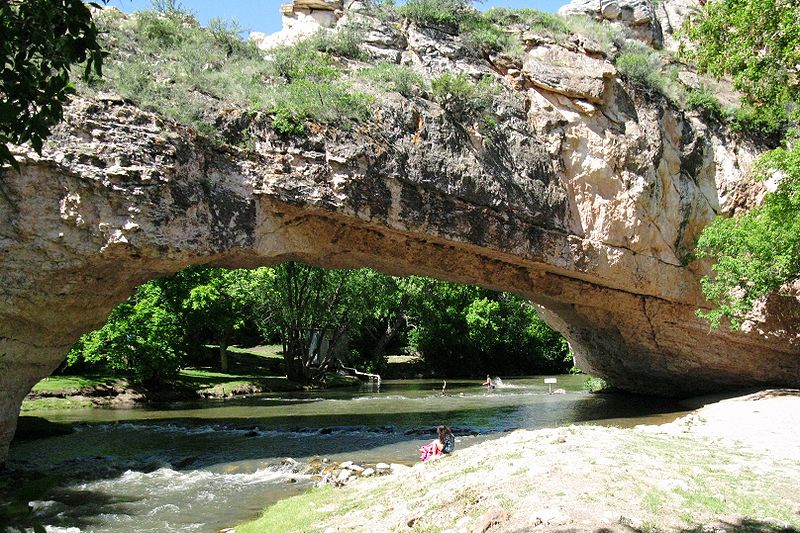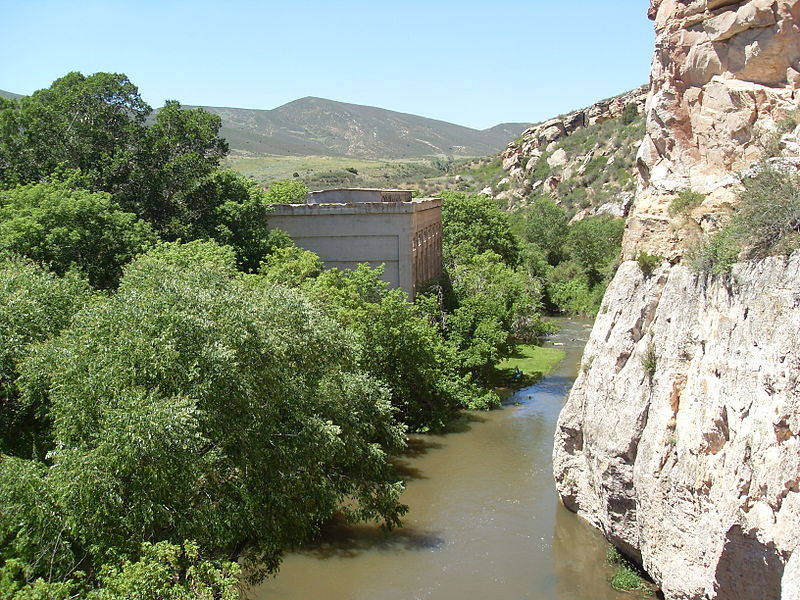
The emigrants to Oregon found many scenic wonders along the way. One of those wonders was (and is) a natural bridge over LaPrele Creek, near what is now Douglas, Wyoming, not far past Fort Laramie. The bridge is 100 feet long and 50 feet above the water, and is one of only three natural bridges in the United States that spans running water. It is surrounded by red rock formations and leafy shade trees – a lovely locale in any century.
The bridge was actually two miles off the Oregon Trail, but many pioneers took sightseeing excursions to the bridge. The emigrants often passed this point in their journey in June, when the weather was perfect, and the Trail was becoming more interesting as it departed the Platte River. They had passed Fort Laramie, where most of the wagon trains rested and replenished, and were headed into the mountains.
As a result of the pioneers’ day trips to the bridge, it is often called one of Wyoming’s first tourist attractions. Many emigrants mentioned it in their journals and diaries. In 1843, one described it as “a natural bridge of solid rock, over a rapid torrent, the arch being regular as tho’ shaped by art.”
I had some of the characters in my novel (set in 1847) take a day away from their wagons to see the bridge. It provided an opportunity for one couple to further their romance, away from the eyes of their parents, but with sufficient chaperonage to satisfy the mores of that era. I’m still editing the book, so I hope this scene survives.

But as I wrote, I had to be careful to be historically accurate. For example, I couldn’t call it the Ayers bridge, because the Ayers name was not attached to the locale until the 1880s, when Alva Ayers settled the land around the bridge. I could use the site in my book, because my research showed that it was well-known before 1847, but I couldn’t use a name that wasn’t given until decades later.
Indian legends held that the bridge was a fearsome and deadly place. A young brave had once been struck by lightning near the site, and the local tribes believed an evil spirit lived below the bridge. In later years of the Oregon Trail, when tensions rose between the Native Americans and the incoming whites, the whites would flock to the bridge to escape the Indians, who were afraid to follow.
In my opinion, the bridge is too lovely to give rise to any fears, other than perhaps of falling fifty feet into the water below. Now Wyoming has made the site into the Ayers Natural Bridge State Park. If you like the pictures I’ve posted of the Ayers bridge, then check out this 360 degree panorama.




Hi Teresa: That was very interesting
. Now I want desperately to see the bridge up close and personal and I can’t wait to read your book! Vickie
Vickie,
I’d like to see the bridge up close, too! I’m hoping to get the Oregon Trail book published in 2014. I’ll keep you posted.
Thanks for reading,
Theresa
[…] wrote last month about Ayers Natural Bridge, and its fame as a day trip for the emigrants to Oregon. Another wonder they encountered along the […]